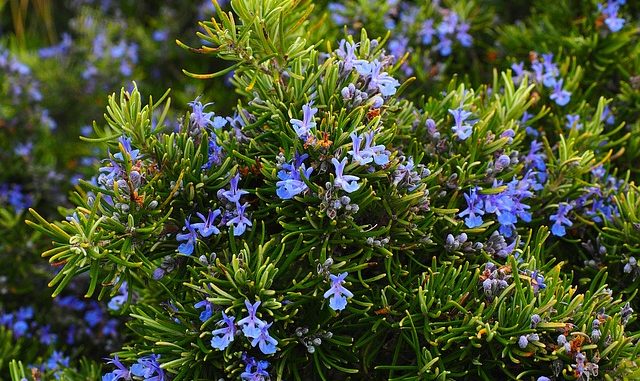
Rosemary is one of the ancient cult plants, closely associated with love and marriage, birth and death. Similarly, rosemary oil is an important anti-microbial which should be better known. In England and Germany it is considered as a symbol of remembrance and is still used in bridal bouquets and in the spring is placed in the cradle of a newly born child to protect it against evil influences and forces. It is sometimes placed in books and among clothes to protect them from moth damage.
As recently as World War Two, French nurses hung rosemary (Rosmarinus officinalis Linn. Fam. Labiatae) in hospitals and burned it with juniper to ward off infection but its rich, fresh fragrance has been used for centuries in a variety of ‘charm’ forms such as warding off witches, disease and even nightmares and bad dreams.
Description Of The Plant
Rosemary is an evergreen branched bushy shrub, attaining a height of about one metre with upright stems, whitish-blue flowers and dark green leaves which are small with edges turned over backward. The aromatic oils are found in pits in the underside of the leaves. It is a popular garden plant but prefers dry, arid conditions. Rosemary was even thought to represent a household run by the woman which led to men tearing up the plants from the garden to defend their manhood.
Rosemary’s most dependable property is in the preservation of meat and food and as the perfect taste enhancer in meat dishes such as lamb or a garnish for potatoes for which it is unequalled.
Rosemary has a woody, evergreen like scent and is perhaps surprisingly a member of the mint family. In recent clinical research, it’s been shown to boost nerve growth factor and support the healing of neurological tissue and brain function. Native to the Mediterranean and lets face it who hasn’t seen it on rough countryside, the wooded evergreen has been used in folk medicine for thousands of years. Rosmarinus” is a Latin word which means “Dew of the Sea” (Ros=Dew; Marinus=Sea).
The essential oil is usually extracted by steam distillation.
The Main Uses Of Rosemary And Its Oil
Its essential oil is used in the industry of perfumes, cosmetics, and soap factory, and in the pharmaceutical industry as a hair stimulant, pesticide and even as a green anti-corrosion material.
- The oils in rosemary are made up of compounds that are antioxidants and in some cases have proved as effective as commercial food preservatives in some instances.
- Rosemary oils are often found as antimicrobials in skin lotions and are used in combination with others herbs such as thyme and sage oils. As with many essential oils it is active against many different types of microbe and some fungi
- Rosemary has also been used to fight infection or bacteria, internally to prevent minor food poisoning and externally for minor cuts and grazes.
- Rosemary’s aroma is strong enough to act as a decongestant and can help relieve congestion caused by colds and flu
- The scent of rosemary can also be used to ward of unpleasant smells on the body so is ideal in washing products as well as a powerful insect repellent.
- The aroma is claimed to stimulate and improve memory – a must for all those students studying for finals.
- Soothes the gut after heavy meals and possible the reason it has been added to so many dishes.
- Relief for muscle aches and pains
More recently, it has become a popular ingredient in many skin and hair care products (Fridd et al., 1986; Vernon, 1991) due to its antiseptic and antimicrobial properties. Researchers are starting to delve deeper into its medicinal characteristics.
The Composition Of Rosemary Oil
The essential oil of rosemary is analysed using gas chromatography coupled to mass spectrometry (GC-MS). 22 compounds have been isolated from the oil and make up 97% of the total number. The main components are 1,8-Cineole (26.54%) and α-Pinene (20.14%) (Jiang et al., 2011).
Rosemary Oil Improves Hair Growth
Rosemary oil is often added to hair products to stimulate growth of hair.
Rosemary Extracts
Rosemary extracts as opposed to the oil have been explored as antioxidants to treat frying oils and reduce the development of off-notes as well as reduce lipid oxidation when meat is cooked. The addition level to uncooked meat prior to frying for example is between 0.5g/kg (Güntensperger et al., 1998).
Please note this post contains links to our affiliate marketing partner. Please read our affiliate disclosure.
Leave a Reply